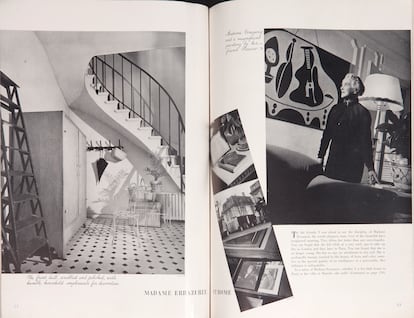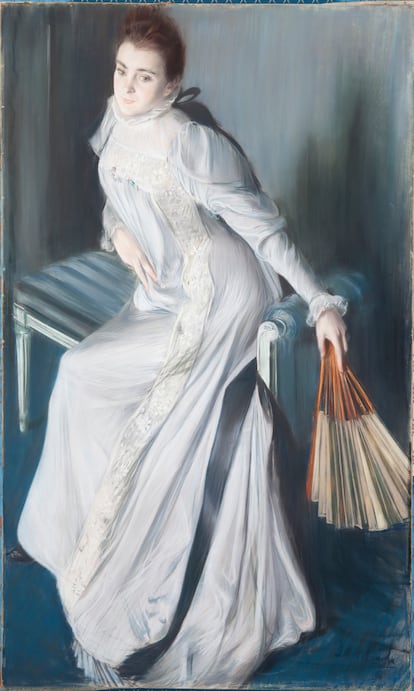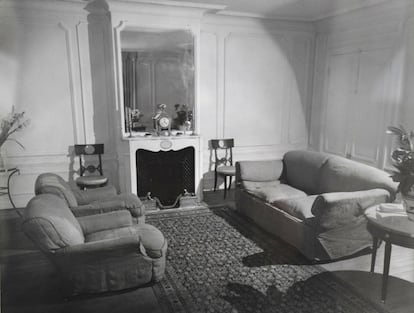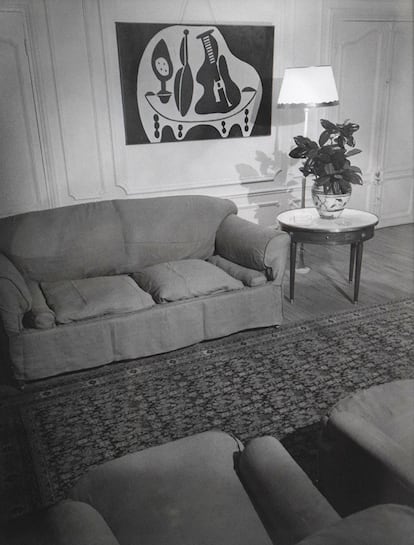Eugenia de Errázuriz, the Chilean Marie Kondo who invented minimalism 100 years ago
She created the aesthetics and rules of interior design that shape contemporary life. Today, millions of homes around the world adhere to the standards that she set

“Everything she did seems like nothing, but who ever conceived things like Eugenia before Eugenia?” pondered writer Victoria Ocampo in a 1949 essay where she admitted to feeling “a little impatient” with the excessive “Eugenism” present at the time in cities like Buenos Aires, Paris, London, and New York. The text by the Argentine intellectual and feminist was a tribute to the Chilean Eugenia de Errázuriz, benefactor of Pablo Picasso and other artists and creator of what we know today as minimalist decoration. It was also a farewell to Errázuriz, who had just died at the age of 89 in her native Santiago, Chile. “With you, one could not know where your spirit began and your matter ended,” Ocampo concluded in her eulogy.
Eugenia Huici Arguedas de Errázuriz was born on November 15, 1860 into a rich family of Basque origin that had made a fortune in mining in Chile and Bolivia. Ironically, the mother of minimalism was born surrounded by opulence and luxury. Her religious education at a school run by English nuns in Valparaíso, Chile, was what shaped her taste for sobriety. On June 6, 1879, at the age of 18, she married the Chilean painter and heir José Tomás Errázuriz, also of Basque origin. The couple moved to Europe, where she began to show the first signs of her asceticism. When she posed for John Singer Sargent, Madame Errázuriz preferred to dress in black and have the painter portray her in nondescript spaces.
But her true conversion took place in the mid-1910s. Now separated from her husband, she went from Victorian wife and mother to independent woman and patron of avant-garde artists such as Jean Cocteau, Arthur Rubinstein, Ambrose McEvoy, Cecil Beaton, René Crevel and Christopher Wood. The “beautiful Chilean,” as she was called in Paris, got Rubinstein to perform at the court of Alfonso XIII in 1916. That same year Errázuriz met Picasso, whom she adopted like a son. The painter from Málaga had just lost his lover and muse, the choreographer Eva Gouel, and found in his new benefactor the emotional and financial support he needed to continue painting. The millionaire acquired Portrait of a Young Woman (1914) and Man with a Pipe (1915), a cubist masterpiece that paved the way for the artist’s first major exhibition in New York. She also arranged a meeting between the painter and Sergei Diaghilev, so that they could work together in the Ballets Russes.

Errázuriz’s houses also began to mutate, going from the excessively ornate Edwardian style of the moment to her own taste, her Eugenism, harsh lines and clean surfaces. For her, furnishing a house meant removing furniture from it. Long before Mies van der Rohe declared that “less is more,” she was already saying: “Elegance means elimination.” In 1918, she bought a villa in Biarritz, France, which she called La Mimoseraie. There she set up her design laboratory. She painted the walls white to make Picasso’s works stand out — she was the first to place a cubist painting on an 18th-century French sideboard — and removed the rugs so that the terracotta floors could shine on their own. “Her need for minimalism arose from her deep Catholic devotion, which led her to believe that objects that served no purpose were indulgent and therefore sinful. She saw the works of art in her home as portals to a deeper spirituality,” explains Julie Pierotti, curator of the Dixon Gallery and Gardens, the Memphis art museum that in 2018 organized the first exhibition dedicated to the Chilean patron.
Eugenism, a mixture of tradition and modernity, aroused the admiration of Cocteau, Stravinsky and Blaise Cendrars. Picasso and Olga Koklova spent their honeymoon at La Mimoseraie in 1918. The hostess set up a studio for her friend and protégé, where he continued to experiment with Cubism. That same summer also led to a meeting between Picasso and the art dealer Nathan Wildenstein; shortly after, Paul Rosenberg, Wildenstein’s associate, reached an agreement to represent the Spanish painter’s work in Europe and the United States.

Cecil Beaton described La Mimoseraie as “a peasant’s house,” and Patricia López-Willshaw, Errázuriz’s great-niece, defined it as a place with “the peace of a convent.” Eugenia herself said: “I love my house as it looks very clean and very poor.” However, her approach to decoration had nothing to do with poverty, but with her very personal vision of what minimalism and functionalism were. In La Mimoseraie everything had one purpose — or more. As Pierotti explains in the catalogue of the exhibition she organized for the Dixon Gallery, a glass could be used as a flower vase or as an ashtray, and a watering can could be a gardening tool and an art object at the same time.
Errázuriz believed that space was the supreme luxury; she was a century ahead of Marie Kondo, the Japanese guru of order. If something didn’t work, she threw it out. In the living room of her house on Avenue Montaigne, in Paris, there were only two paintings by Picasso and a couple of sofas, and in the foyer, some iron garden chairs that she had bought in the Bois de Boulogne park. In the fall of 1918, Marcel Proust paid her a visit and was so impressed with what he saw that he included the following reference to her in Time Regained (1927): “And, like those illustrious ladies in the eighteenth century who became religious, they lived in flats full of cubist paintings, with a cubist painter working only for them and they living only for him.”
The trendsetting women of the time, including Coco Chanel, Elsa Schiaparelli and Victoria Ocampo, began to follow and imitate her. Even though she was never considered a professional decorator, everyone asked for her advice. She only had one recommendation: “Throw out and keep throwing out. Elegance means elimination.” As for her disciples, the photographer Cecil Beaton wrote in The Glass of Fashion (1954) that “like sunflowers turning to the sun, they looked to Madame Errázuriz for a redefinition of elegance, taste, and love of the beautiful.”

The “beautiful Chilean,” a fervent Catholic, became a lay member of the Franciscan order, and her habit was a black shift designed for her by Chanel. In the end she created her own religion, and the French interior decorator Jean-Michel Frank became her most devoted disciple. In 1935, Frank and Alberto Giacometti created a collection of iron furniture inspired by those in Errázuriz’s home. “Her approach to high-quality minimalism inspired some of the most important artists, writers, musicians, designers and architects of her time,” notes Pierotti. Eugenism influenced Madeleine Castaing, grand dame of French decoration, and architects such as the Swiss Le Corbusier or the Argentine Alejandro Bustillo. At the end of the 1920s, Bustillo designed the first modernist residence in Buenos Aires for Victoria Ocampo.
When she reached old age, Eugenia de Errázuriz realized that she had spent her entire fortune on houses and works of art. In the early 1940s, on the brink of bankruptcy, she began to sell her Picassos. In March 1948, at the age of 87, she returned to her native Chile. One of her daughters bought her a house in Santiago, decorated to her liking. Before she died, Madame Errázuriz carried out her final act of minimalism: she destroyed most of the letters and souvenirs she had collected throughout her life. She never wrote to her artist friends again, and she stopped eating. “I want to help God take me out of this world,” she told her family. On November 26, 1949, shortly after turning 89, she died as she had lived: surrounded by simplicity. Her last words were: “I die how I want to die. Everything else is vanity, vanity.”
“Her effect on the taste of the last 50 years has been so enormous that the whole esthetic of modern interior decoration, and many of the concepts of simplicity which are so generally acknowledged today, can be laid at her remarkable doorstep,” wrote Cecil Beaton in The Glass of Fashion. Nonetheless, Errázuriz remains unknown to many. “Perhaps because she was a woman and not an artist, but a patron of the arts, her story has been overlooked by art history,” concludes Pierotti. “But now that so many stories of important women are being unearthed, it’s a good time to really appreciate her profound effect.”
Sign up for our weekly newsletter to get more English-language news coverage from EL PAÍS USA Edition
Tu suscripción se está usando en otro dispositivo
¿Quieres añadir otro usuario a tu suscripción?
Si continúas leyendo en este dispositivo, no se podrá leer en el otro.
FlechaTu suscripción se está usando en otro dispositivo y solo puedes acceder a EL PAÍS desde un dispositivo a la vez.
Si quieres compartir tu cuenta, cambia tu suscripción a la modalidad Premium, así podrás añadir otro usuario. Cada uno accederá con su propia cuenta de email, lo que os permitirá personalizar vuestra experiencia en EL PAÍS.
¿Tienes una suscripción de empresa? Accede aquí para contratar más cuentas.
En el caso de no saber quién está usando tu cuenta, te recomendamos cambiar tu contraseña aquí.
Si decides continuar compartiendo tu cuenta, este mensaje se mostrará en tu dispositivo y en el de la otra persona que está usando tu cuenta de forma indefinida, afectando a tu experiencia de lectura. Puedes consultar aquí los términos y condiciones de la suscripción digital.
More information
Archived In
Últimas noticias
Maduro to be tried in the US for narcoterrorism and corruption
Maps of the US attack on Venezuela: Targets, airspace and deployed fleet
Venezuelans in exile: ‘This could be the end of a very dark chapter for Venezuela, but also the beginning of a time of uncertainty’
Key points of the military attack on Venezuela: Early morning bombings and a ‘captured’ president
Most viewed
- Alain Aspect, Nobel laureate in physics: ‘Einstein was so smart that he would have had to recognize quantum entanglement’
- David King, chemist: ‘There are scientists studying how to cool the planet; nobody should stop these experiments from happening’
- Mexico completes its trade shift with the entry into force of tariffs on China and countries without trade agreements
- Reinhard Genzel, Nobel laureate in physics: ‘One-minute videos will never give you the truth’
- Oona Chaplin: ‘I told James Cameron that I was living in a treehouse and starting a permaculture project with a friend’











































